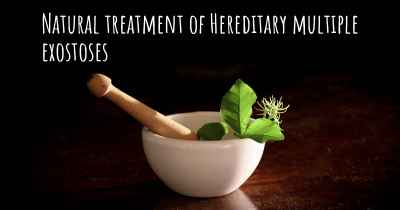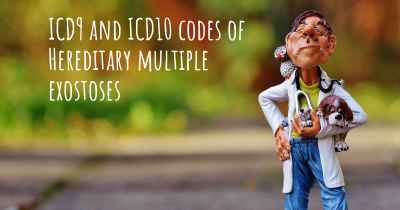Which are the causes of Hereditary multiple exostoses?
See some of the causes of Hereditary multiple exostoses according to people who have experience in Hereditary multiple exostoses

Hereditary multiple exostoses (HME), also known as multiple osteochondromas, is a rare genetic disorder characterized by the development of multiple benign bone tumors called osteochondromas. These tumors typically grow near the growth plates of long bones, such as the femur, tibia, and humerus, but can also occur in other bones of the body. HME is inherited in an autosomal dominant manner, meaning that a person only needs to inherit one copy of the mutated gene from either parent to develop the condition.
The primary cause of Hereditary multiple exostoses is mutations in the EXT1 or EXT2 genes. These genes provide instructions for producing proteins that are involved in the normal development and maintenance of cartilage and bone. Mutations in either of these genes disrupt the normal functioning of the proteins, leading to the formation of osteochondromas.
EXT1 and EXT2 genes encode glycosyltransferases that are responsible for adding sugar molecules to a specific type of protein called heparan sulfate. Heparan sulfate is a component of a larger molecule called proteoglycan, which is essential for the structure and function of cartilage. The addition of sugar molecules to heparan sulfate is crucial for its proper function in signaling pathways that regulate cell growth and differentiation.
When EXT1 or EXT2 genes are mutated, the glycosyltransferase activity is impaired, leading to abnormal heparan sulfate production. This disruption in heparan sulfate synthesis affects various signaling pathways involved in bone and cartilage development, resulting in the formation of osteochondromas.
It is important to note that not all individuals with mutations in the EXT1 or EXT2 genes will develop Hereditary multiple exostoses. The severity and extent of the condition can vary widely among affected individuals, even within the same family. This suggests that other genetic and environmental factors may influence the development and progression of the disease.
While Hereditary multiple exostoses is primarily caused by genetic mutations, it is important to understand that these mutations are usually inherited from an affected parent. In some cases, however, the mutations can occur spontaneously during early embryonic development, without being inherited from either parent. This phenomenon is known as a de novo mutation.
It is also worth mentioning that Hereditary multiple exostoses is a rare disorder, with an estimated prevalence of approximately 1 in 50,000 individuals. The condition affects both males and females equally and can be found in various ethnic groups worldwide.
Diagnosis of Hereditary multiple exostoses is typically based on clinical evaluation and imaging studies. X-rays, CT scans, and MRI scans can help visualize the osteochondromas and assess their size, location, and potential complications. Genetic testing can also be performed to identify mutations in the EXT1 and EXT2 genes, particularly in cases where the diagnosis is uncertain.
Management of Hereditary multiple exostoses focuses on monitoring and addressing the symptoms and complications associated with osteochondromas. Regular follow-up visits with orthopedic specialists are essential to monitor the growth of the tumors and assess any potential complications, such as nerve compression, skeletal deformities, or malignant transformation. Surgical intervention may be necessary in cases where the osteochondromas cause significant pain, functional impairment, or pose a risk to surrounding structures.
In conclusion, Hereditary multiple exostoses is primarily caused by mutations in the EXT1 or EXT2 genes, which disrupt the normal functioning of glycosyltransferases involved in heparan sulfate synthesis. This disruption affects signaling pathways crucial for bone and cartilage development, leading to the formation of osteochondromas. While the condition is inherited in an autosomal dominant manner, de novo mutations can also occur. Diagnosis is typically based on clinical evaluation and imaging studies, and management involves monitoring and addressing symptoms and complications associated with osteochondromas.
Posted Nov 30, 2017 by Zahra 1950








